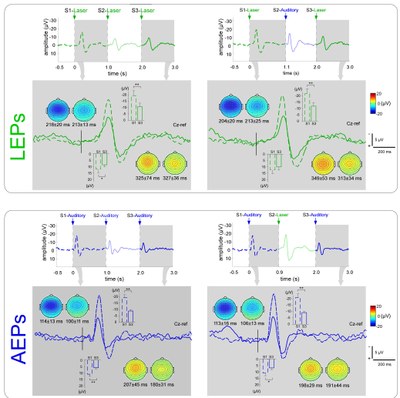- Info
New evidence to explain 'response decrement' in sensory ERPs
Anli Wang (University of Oxford), Meng Liang (University College London), Giandomenico Iannetti (University College London)
Response decrement is
observed in sensory ERP studies when stimuli are repeated. Previous studies
suggested that lack of saliency in the eliciting stimulus offered an explanation for this phenomenon. Saliency
is defined by the contrast by which a given physical feature (e.g. modality,
intensity or spatial location) differs relative to the surrounding sensory
input or to the preceding sensory input. However, whether introducing saliency
by changing the modality of preceding stimulus can recover the reduced response
or not remains unanswered. In the present study, trains of three stimuli
(S1-S2-S3) with inter-stimulus interval (ISI) of 1 second (1-s) were presented
to 11 subjects and their scalp event-related potentials (ERPs) were recorded.
To see if the reduced cortical response to S3 would be recovered by changing
the modality of the preceding stimulus (S2), unisensory train (i.e. S2
belonging to the same modality as S1 and S3) and bisensory train (i.e. S2
belonging to the different modality) were presented. Unisensory and bisensory
trains were randomly delivered in the laser-dominating block (L-L-L and L-A-L) and in the
auditory-dominating block (A-A-A and A-L-A). Our results show that ERPs elicited
by the laser- and auditory-S3, as well as ERS induced by the laser- and
auditory-S3, decrease in amplitude with the stimulus repetition, regardless of
changing modality of S2. In contrast, the laser- and auditory induced
event-related dyscynchronization (ERD) is not reduced as a function of stimulus
repetition. These results further support the notion that the cortical response reflects a transient prediction
error encoding the discrepancy between prediction and actual input, thus the
cortical responses are reduced in amplitude when the input information accords
with the prediction, but not
when the input information is salient to its context.

Figure.2 Effect of stimulus repetition on the amplitude of LEPs and AEPs elicited by S1 and S3 of the unisensory and bisensory trains
Epochs are classified according to the category of the train, yielding four grand average waveforms: L-L-L, L-A-L, A-A-A and A-L-A. Green arrows indicate the onset of the laser stimulus and the green waveforms represent the laser-evoked potentials (LEPs). Blue arrows indicate the onset of the auditory stimulus and blue waveforms represent the auditory-evoked potentials (AEPs). Top panel: upper row – grand average ERPs of the L-L-L and L-A-L train (Cz vs. nose reference). x-axis, time (s). y-axis, amplitude (μV); lower row – grand average LEP elicited by S1 (dashed line in green) and S3 (solid line in green) of each train were superimposed, the black vertical line indicates the onset of stimuli. The scalp maps of S1 and S3 eliciting LEP were displayed corresponding to the N2 and P2 peaks. Histograms show the average amplitude of N2 and P2 waves elicited by S1 (the column edged by green dashed line) and S3 (the column edged by green solid line), error bars (SEM) show variance across subjects (* p <0.05; ** p <0.01, paired t-test). Note the LEP amplitude elicited by S3 is significantly reduced as a result of stimulus repetition regardless of the modality of the preceding stimulus (S2). Bottom panel: upper row – grand average ERPs of A-A-A and A-L-A train (Cz vs. nose reference). x-axis, time (s). y-axis, amplitude (μV); lower row – grand average AEP elicited by S1 (dashed line in blue) and S3 (solid line in blue) of each train were superimposed, the black vertical line indicates the onset of stimuli. The scalp maps of S1 and S3 eliciting AEP were displayed corresponding to the N1 and P2 peaks. Histograms show the average amplitude of N1 and P2 waves elicited by S1 (the column edged by blue dashed line) and S3 (the column edged by blue solid line), error bars (SEM) show variance across subjects (* p <0.05; ** p <0.01, paired t-test). Note the AEP amplitude elicited by S3 is significantly reduced as a result of stimulus repetition regardless of the modality of the preceding stimulus (S2).
Preferred presentation format:
Poster
Topic:
Electrophysiology


 Latest news for Neuroinformatics 2011
Latest news for Neuroinformatics 2011 Follow INCF on Twitter
Follow INCF on Twitter
